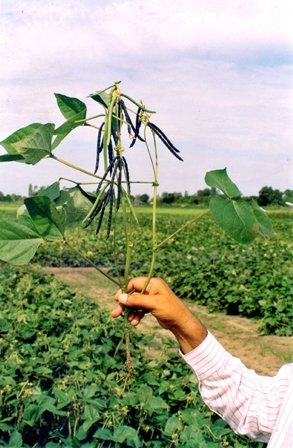Tainan, Taiwan
September, 2006
New varieties of mungbean are
providing a fast food for south Asia that is not only highly
nutritious, but can be squeezed into a vacant niche in between
other major food crops.
With the price
of meat well over what most people in the world can afford,
looking for practical alternative sources of protein becomes a
matter of survival.
Legumes with
their high protein content are a great option. Mungbean in
particular has 24% easily digestible protein, high iron content,
and significant amounts of calcium, phosphorus, and some
essential vitamins. It is also highly versatile - eaten as
appetizing bean sprouts for salads and side dishes, sautéed,
turned into noodles or delicious dhal, providing the base for
exotic soups or even used as a mouth-watering bread filling.
Scientists in
South Asia, in a project supported by the
World Vegetable Center
(AVRDC), looked at how mungbean production could be improved in
the region not only to provide cheap protein but also to raise
the income of farmers.
Through the
project’s three-year multi-locational and multi-seasonal trials
conducted in the region, Bangladesh and India were able to
develop and release improved cultivars with high yields of 1.5
tonnes per hectare, maturing evenly in only 60-65 days. Such
fast evenly maturing varieties are preferred because they can be
grown in between other major crops and harvested before the
onset of rains. Other varietal features developed were large
shiny seeds and resistance to thrips and mungbean yellow mosaic
virus.
 Several
improved mungbean varieties were developed and evaluated during
the project including the World Vegetable Center's UPM 98 or
Pant Mung-5 (photo); India’s SML 668, NM-92, Pusa Bold (Pusa
Vishal); Bangladesh’s IPK-1040-94, BARImug 2 and BUmug 2; and
Nepal’s VC 6372 (45-8-1). Most of these are now being
distributed through seed dispersal and technology dissemination
programs in the Indo-Gangetic Plains of South Asia. Several
improved mungbean varieties were developed and evaluated during
the project including the World Vegetable Center's UPM 98 or
Pant Mung-5 (photo); India’s SML 668, NM-92, Pusa Bold (Pusa
Vishal); Bangladesh’s IPK-1040-94, BARImug 2 and BUmug 2; and
Nepal’s VC 6372 (45-8-1). Most of these are now being
distributed through seed dispersal and technology dissemination
programs in the Indo-Gangetic Plains of South Asia.
For some of
these varieties the benefits were very obvious. For instance,
the extraordinary Pusha Vishal is an extra-short duration
variety which matures in only 55 days and yields up to 43.3%
over the traditional varieties. Pant Mung-5, on the other hand,
is resistant to MYMV, Cercospora leaf spot, and
Anthracnose diseases.
“The benefits of
this project are currently being extended to some of the poorest
areas of South Asia,” World Vegetable Center Director General
Thomas Lumpkin said. Even so, he asks governments in South Asia
to “support mungbean research and development activities, and
help develop policies ensuring appropriate market price for
mungbean and other legumes.”
The next task of
the breeding programme will be to work with farmers to produce
varieties with better drought tolerance for use in marginal and
semi-arid situations. Farmers also need more research on
management of insects such as pod borer, white fly and weevils
and the control of diseases such as Cercospora leaf spot and
powdery mildew.
Armed with new
varieties from the World Vegetable Center, farmers are now much
better able to take advantage of mungbeans in their cropping
systems to grow healthy fast food. |